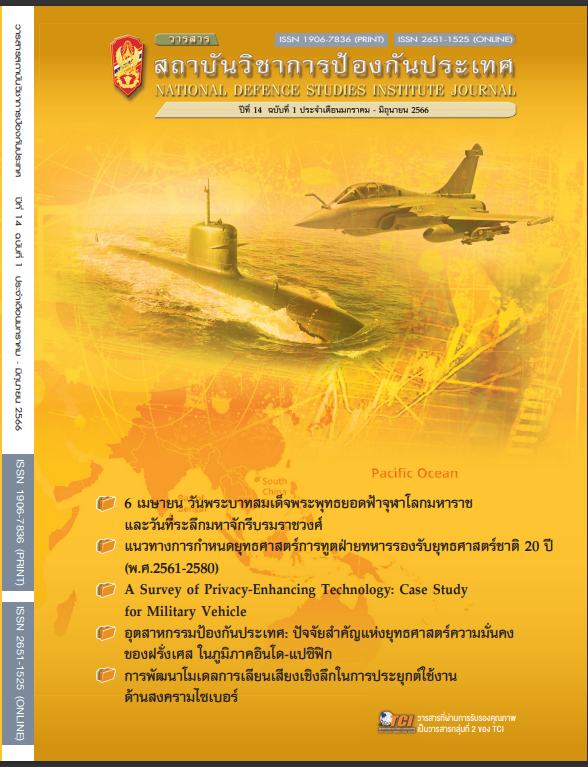The The Analysis of Environmental Factors Based on ASCOPE and the Development of JIPOE Information by Advanced Technique under the Research Project on Multidimensional Environmental Assessment of River Basins in Southern Border Provinces for Peace and Security
Main Article Content
Abstract
This data analysis is part of the research project, with the objectives to 1) survey environmental factors of river basins in southern border provinces, 2) analyze environmental factors of river basins in southern border provinces, 3) develop JIPOE (Joint Intelligence Preparation of the Operational Environment) information under the context of social-ecological change in the areas by ASCOPE (Area, Structure, Capability, Organization, People, Events). The mixed methodology consists of documentary, quantitative and qualitative research with analyze environmental factors of river basins develop JIPOE information by ASCOPE
The analysis results revealed that there were three main tributary river basins in southern border provinces, i.e., 1) Khlong Tepa River Basin and Pattani River Basin or called together “Khlong Ta Rua River Basin,” 2) Sai Buri River Basin and 3) Bang Nara Tributary River Basin and Golok Tributary River Basin. When these 3 river basins were analyzed, they could be divided into upstream, midstream, and downstream. To clarify, 1) upstream areas are mostly mountain forests lying down to the west of Thailand. Community villages are hill villages. Villagersusually rely on nature to make a living. 2) Midstream areas are mostly swamp forests and lowlands. The way of life among local inhabitants is related to rivers and swamp forests, with strong Muslim communities. 3) Downstream areas are mouths of the rivers, with the fishery in the way of seamen. Some parts are key economic urban areas. Local inhabitants include Thai-Muslim, Thai-Buddhist, and Thai-Chinese.
Article Details

This work is licensed under a Creative Commons Attribution-NonCommercial-NoDerivatives 4.0 International License.
The articles, images, tables, graphs, written content, and opinions published in this journal are solely those of the authors and do not necessarily reflect the views or positions of the National Defence Studies Institute or its academic affiliates.
References
เกษม จันทร์แก้ว. (2551). หลักการจัดการลุ่มน้ำ. กรุงเทพฯ: มหาวิทยาลัยเกษตรศาสตร์ วิทยาลัยสิ่งแวดล้อม.
จารุวรรณ ขำเพชร, ถวัลย์ ภูถวัลย์, พงษ์ศักดิ์ ขำเพชร, วรรณรัตน์ รัตนวรางค์, อดิศร เสมแย้ม, และอนุพันธ์ คำปัน.(2553). โครงการสายน้ำ: สายชีวิตและวัฒนธรรมคนริมน้ำ. กรุงเทพฯ: มหาวิทยาลัยศรีนครินทรวิโรฒ.
เจน สุขศรีทอง. (2563). การพัฒนาประสิทธิผลการนำนโยบายสังคมพหุวัฒนธรรมไปสู่การปฏิบัติในจังหวัดชายแดนภาคใต้ (ปริญญานิพนธ์ปริญญาดุษฎีบัณฑิต สาขายุทธศาสตร์และความมั่นคง).
ศรีศักร วัลลิโภดม. (2551). ความหมายของภูมิวัฒนธรรม การศึกษาจากภายในและสำนึกของท้องถิ่น. กรุงเทพฯ: มูลนิธิเล็ก-ประไพวิริยะพันธุ.
ศรีสมภพ จิตรภิรมณ์. (2557). การเปลี่ยนผ่านทางการเมืองและการสื่อสารเพื่อสร้างสันติภาพ : แนวคิดและประสบการณ์ :รวมปาฐกถาจากการประชุมวิชาการนานาชาติ (2557-2560). ปัตตานี: สถานวิจัยความขัดแย้งและความหลากหลายทางวัฒนธรรมภาคใต้ มหาวิทยาลัยสงขลานครินทร์ วิทยาเขตปัตตานี
สำนักนายกรัฐมนตรี, สำนักงานสภาความมั่นคงแห่งชาติ. (2562). นโยบายและแผนระดับชาติว่าด้วยความมั่นคงแห่งชาติ (พ.ศ.2562-2565). กรุงเทพฯ.
หัสชัย คงมีสุข, อาทิตย์ ภูผินผา, และปุรเชษฐ บุญยัง (2564). พื้นที่ทางจิตวิญญาณคนนครศรีธรรมราช. ในการประชุมวิชาการระดับชาติ ภูมิศาสตร์และภูมิสารสนเทศศาสตร์มหาวิทยาลัยในภาคใต้ ครั้งที่ 1. สงขลา: คณะมนุษยศาสตร์สังคมศาสตร์ มหาวิทยาลัยทักษิณ.
อนุกูล ตันสุพล. (2559). นิเวศวิทยาวัฒนธรรม: กุญแจสู่การพัฒนาที่ยั่งยืน. วารสารวิชาการ คณะมนุษย์ศาสตร์และสังคมศาสตร์, 12(1), 193-221.
อภิวัฒน์ สมาธิ, ภาณุ ธรรมสุวรรณ, กรกฎ ทองขะโชค, และกฤษกร พลีธัญญวงศ์. (2561). การแก้ปัญหาความมั่นคงในสามจังหวัดชายแดนภาคใต้ กรณีศึกษา โครงการกำปงตักวาและโครงการพาคนกลับบ้าน. วารสารสถาบันวิชาการป้องกันประเทศ, 9(3), 45-59.
อำนาจ ขำทวีพรหม. (2561). นิเวศวิทยาวัฒนธรรมข้าวในลุ่มน้ำห้วยเสนง. วารสารมนุษย์และสังคม มหาวิทยาลัยราชภัฏศีรษะเกษ, 2(2), 124-142.
Headquarters, Department of the United States Army. (2014). Insurgencies and Countering Insurgencies (FM 3-24 /MCWP 3-33.5). Retrieved July 20, 2021 from https://armypubs.army.mil
Huntington, S. P. (1996). The Clash of Civilizations and the Remaking of World Order. New York: Simon & Schuster Rockefeller Center


